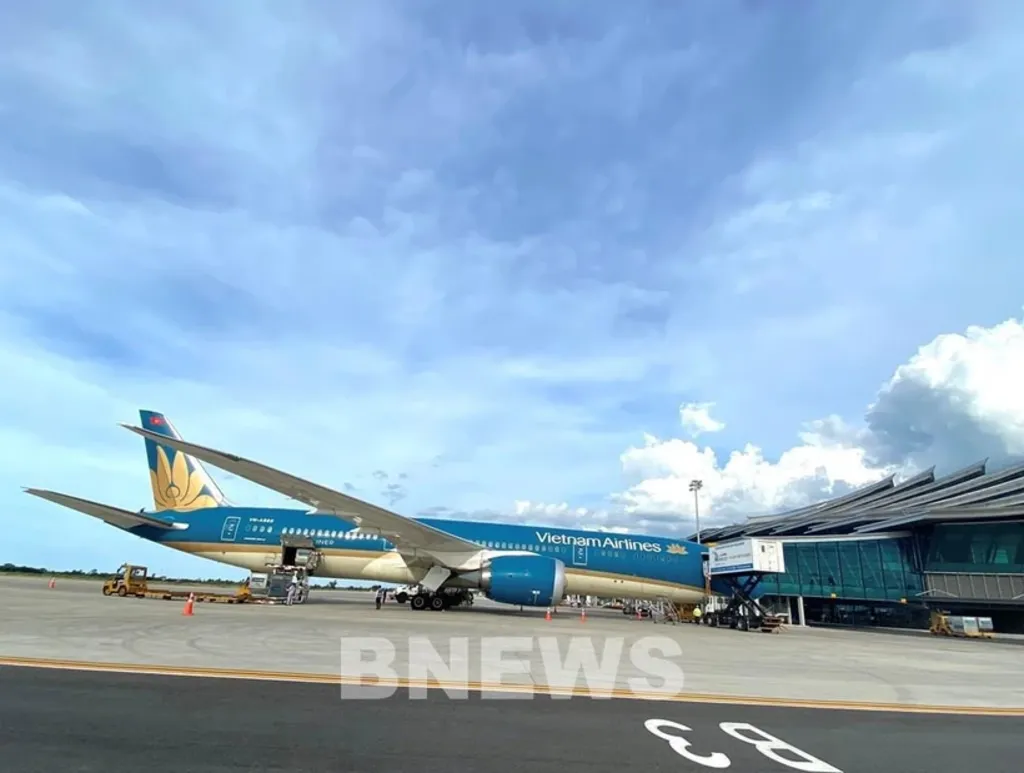 |
| Vietnam Airlines operates super wide-body aircraft Boeing 787 to Hue__Photo: VNA |
Vietnamese airlines have worked hard to implement the net zero emission targets by using new generation aircraft in their operation, which are more environmentally friendly thanks to advanced technologies.
Recently, the national flag carrier Vietnam Airlines announced that it will start operating wide-body aircraft on routes between Hanoi and Shanghai and Beijing, alongside Airbus A321, from June this year; and wide-body aircraft for all flights between Ho Chi Minh City and Shanghai from July.
With an optimized design, wide-body aircraft such as Boeing 787 and Airbus A350 can carry between 311-367 passengers, and have larger cargo capacity compared to narrow-body ones, thereby increasing efficiency and competitiveness on routes.
Notably, the new generation aircraft are particularly environmentally friendly due to the integration of advanced technology that helps reduce fuel consumption and emissions.
Vietjet has also continuously added new-generation, modern, safe, and environmentally friendly aircraft to its fleet which now counts 105 aircraft, including wide-body A330s, which contribute to optimizing resources, saving fuel, and helping the airline achieve its ESG (environmental, social, and governance) goal.
A330s aircraft can save up to 20 percent in fuel consumption, and reduce environmental emissions by up to 50 percent and noise levels by up to 75 percent.
Beginning its journey to reduce carbon emissions over 10 years ago, the development of a new and modern fleet of Vietjet plays a crucial role in optimizing resources, saving fuel, and reducing CO2 emissions. The airline's modern fleet can save 15-20 percent in fuel consumption, and reduce emissions per passenger by 25-30 percent compared to other airlines.
Additionally, Vietjet allocates VND 5,000 (less than USD 0.2) from each flight ticket sold to the Fly Green Fund for environmental protection activities, sustainable development, and research and development of green technologies.
Experts stressed that it is necessary to promptly issue Vietnamese standards for sustainable aviation fuel, and have appropriate legal mechanisms to create a legal framework for businesses to apply modern technology and techniques in operating sustainable fuel supply chains.
According to Nguyen Phuoc Thang, head of the Science, Technology and Environment Department of the Civil Aviation Authority of Vietnam, the best solution to reduce CO2 is to use sustainable aviation fuel.
Vietnam needs a comprehensive national roadmap that outlines the specific actions each sector must take, especially those related to carbon credits, and production of sustainable materials, he said.
He revealed that Vietnamese airlines are actively completing documentation to participate in the process of carbon reduction and offsetting.
According to specialized studies, the aviation industry accounts for approximately 2 percent of the global emissions and is one of the most challenging sectors to reduce carbon emissions in transportation activities.
he roadmap for transitioning to green energy in the aviation sector has been stipulated in the Prime Minister’s Decision 876 dated July 22, 2022. Vietnam is researching the use of alternative fuels to partially replace traditional aviation fuels. The roadmap until 2050 aims to transition to using 100 percent green energy, sustainable aviation fuel for aircraft to minimize greenhouse gas emissions.-(VNA/VLLF)









